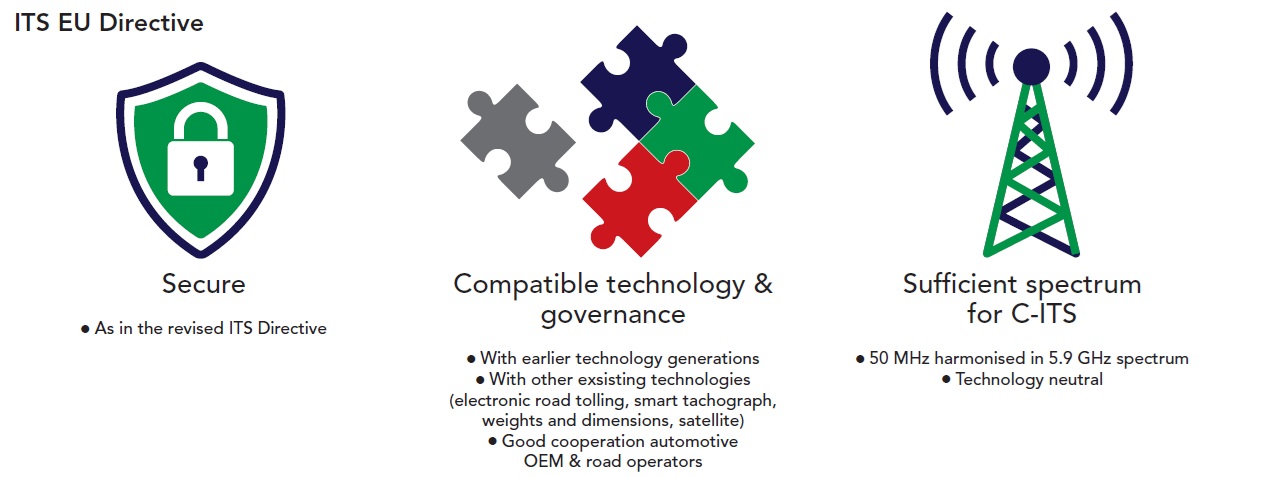
Directive (EU) 2023/2661 of the European Parliament and of the Council of 22 November 2023 amending Directive 2010/40/EU on the framework for the deployment of Intelligent Transport Systems in the field of road transport and for interfaces with other modes of transport
Recently I watched Steven Spielberg’s 2002 sci-fi action classic Minority Report (set in the year 2054). Have you seen it? You remember the scene where Tom Cruise is in a self-driving vehicle? Was that not the ‘vehicle merging’ cooperative ITS (C-ITS) Day 3 use case? Those super-efficient highways? The vehicles have to be aware of each other and the infrastructure too. (In the movie, Cruise is actually quite exposed as a vulnerable road user. Spielberg could have anticipated more standards covering VRUs – although just the idea of the great director foreseeing the European Union’s Smart and Sustainable Mobility Strategy is funny in a nerdish way).
Still, the brave new world is not that far removed from what transport planners probably once dreamed of when thinking of a future advanced transport system. A system where all fits together. Without getting into too much regulatory detail: Minority Report reeks of interoperability and full integration of the vehicle and the infrastructure.
Rewind from that futuristic transport system back to our rough-and-tumble present. The ITS Directive has just been revised, and it contains outlines of a vision of how a European connected road transport system could look.
A Directive is a type of EU law. It is directed at the EU Member States, which are obliged to implement it. EU Directives, broadly speaking, address the EU single market, predominantly consumer safety, interoperability and fair competition between EU companies.
This one shares some basics with that Minority Report world, namely the full integration of vehicles and roads and both forming an ecosystem.
What does the European ITS Directive actually say?
The broad strokes are: one eco-system, no monopolies. The ITS Directive envisions seamless ITS and it envisions ITS to be centred around the vehicle and roads - rather than around communication technology. It foresees an environment in which ITS for the public good is regulated through specifications to create a non-discriminatory market for ITS in Europe. The ITS Directive will be of particular relevance to C-ITS.
For adopting EU legislation the Member States come together as the Council - one of the two co-legislators - the other being the European Parliament that consists of elected Members of European Parliament (MEPs). The ‘ordinary legislative procedure’ is the most common.
A quick look at the principles for specification and deployment give an idea of how the European Parliament and Member States think ITS should look:
a) Interoperability: so all who need to can understand each other. This is a principle in Annex II and again specifically highlighted for Vehicle to Everything (V2X) – which is C-ITS in EU lingo - in recital 12.
b) Backward compatibility: no disruptions through incompatible technologies or technology generations, updates etc. This is a principle in Annex II. Recital 21 also touches upon backward compatibility, as the legislator tasks the European Commission to look into the disruptive effects of changes of cellular technology generations for road safety, in this case eCall – the EU-wide system which automatically makes a free 112 emergency call if your vehicle is involved in a serious road accident.
c) Respect national infrastructure, including its specificities: this alludes to electronic road charging systems, existing C-ITS systems and the like. This is of importance for radio spectrum regulation. ITS electronic communications networks increasingly appear along road networks and need to be coordinated to avoid radio interference. Radio interference reduces road safety and toll road operators’ revenue. It also obstructs the work of enforcement authorities which use electronic communications networks for remote checks on HGVs in Europe.
d) Coherence with EU law and policies: a particularly rich and complex principle, this includes items such as existing EU rules, standards or technology neutrality. The principle of coherence is padded by further references. It relates to recital 35, which highlights that the Commission has to involve the Member State Committees on smart tachograph and road charging, among others, in its decision making. This again relates to radio spectrum and is meant to prevent radio interference.
Same goes for the reference to the European Electronic Communications Code 2018/1972, which is always quoted in relation to technology neutrality. It frames technology neutrality under the current system of general authorisations and other provisions in the Code. C-ITS in Europe runs under a general authorisation on the 5.9 GHz frequency band. In a nutshell, technology neutrality has to fit into current laws and standards.

The finer lines, nuances on C-ITS & a cracker
On C-ITS, the ITS Directive carries a lot of the lessons learnt from the failed C-ITS Delegated Act. Delegated Acts and Implementing Acts are subordinated to their ‘mother legislation’. In a nutshell: Delegated Acts are mainly found in Directives or Regulations (anything under the ordinary legislative procedure), they amend or supplement non-essential elements of legislation. Since here details are added to EU legislation, the Commission, the Parliament and the Council have a say. ‘Implementing acts’ are intended to facilitate the uniform application of the law across Europe and do not change any of the legal provisions of the law. Since it’s about implementation - and this is a Member State responsibility - they have most say here.
“On C-ITS, the ITS Directive carries a lot of the lessons learnt from the failed C-ITS Delegated Act”
Anyway, the new ITS Directive takes several elements from the Delegated Act and elevate them to the level of a Directive.
First, it defines C-ITS legally: the legal definition from that previous attempt has been elevated to the text of the Directive. Previously, C-ITS was more or less defined as V2X under a single EU credential management system. Little change here, but throw in that the actors have to able to exchange among each other ‘without prior knowledge’ and in a ‘non-discriminatory manner’. It’ll be fun mulling over this: looking at it from a purely technical angle, short-range V2X communication is covered. The definition is about messages, not technology; technology just needs to be in the security credential management system.
So here's the cracker: the C-ITS security credential management system is part of the Directive and administered by the European Commission. This makes Europe unique: it’s no project, no pilot or trial - the EU has created a piece of security infrastructure that will define V2X in Europe (remember, it’s C-ITS for EU policy buffs). I know of no other region that has one and I am sure it will play a role beyond V2X.
The Directive constitutes a legal basis for processing personal data for specified ITS services. For C-ITS this means that the services can operate without having to ask the user’s consent. Be sure, the specifications will contain ample provision how to protect personal data. This applies to all specified ITS, including C-ITS, since the Directive also foresees specifications in the area of C-ITS (see Annex I 4.2). Interesting legal detail: a Delegated Act is not ‘senior’ enough to constitute a legal basis for processing personal data, it requires the full agreement of Parliament and the Member States in the Council. Also a discussion point from the C-ITS Delegated Act: solved!
Finally, the ITS Directive addresses the formal cause of the failure of the C-ITS Delegated Act in 2019. Back then, the Council argued that it was broader than its legal basis - the old ITS Directive. The argument went that the failed C-ITS Delegated Act gave the Commission more powers than the Council had granted the Commission through the ‘old ITS Directive’.
Anybody who knows the EU, knows this is a ‘mega no-no’ and the Member States know no mercy when defending this principle. The new ITS Directive contains (article 7a) an interim clause that makes it clear what the Commission is allowed to do in a case of emergency and what not.
A word on taxonomy
Nice touch! The ITS Directive highlights that the Taxonomy Regulation has to consider better traffic management and modal shift, beyond simply promoting increasingly cleaner transport vehicles or vessels.
The Parliament and the EU Member States have agreed and the changes of the ITS Directive have been adopted - so from Minority Report to majority rapport. The ITS Directive further consolidates the EU’s unique V2X ecosystem, it adds cybersecurity to the legal consolidated aspects, the other being radio spectrum.
The close cooperation between automotive OEMs and road operators is the third European unique selling point.

ABOUT THE AUTHOR:
Richard Lax is corporate expert EU Affairs at Kapsch TrafficCom
___________________________________________________________________________________________________________________________________________________________
C-ITS and its history
Scroll to the bottom of this generally useful page of V2X in Europe (in EU lingo: C-ITS). You’ll find the security credential management and how it works in detail there.
Here: the ‘old ITS Directive’ & the text of the ‘new ITS Directive’ as it was adopted in the European Parliament.
For ITS historians, here's the text of the failed C-ITS Delegated Act (DISCLAIMER: this document was not binding) and the foundations for the ITS Directive were laid in a multi-year industry dialogue the C-ITS Deployment Platform.
How does the EU legislative process work?
The European Commission, the EU’s civil service, is tasked to propose EU legislation, while the co-legislators are tasked with the political decision-making. The Council’s Presidency chairs the discussions within the Council and represents the Council vis-à-vis the Parliament. The Council’s presidency rotates every six months. Parliament is represented by the Rapporteur of a certain dossier. EU legislation then passes through various readings and the ever mysterious so-called ‘trilogue’, when Council and Parliament sit down and negotiate text. This process has just been completed for the ITS Directive, it’s adopted and awaits its translation into the EU languages and its publication.










